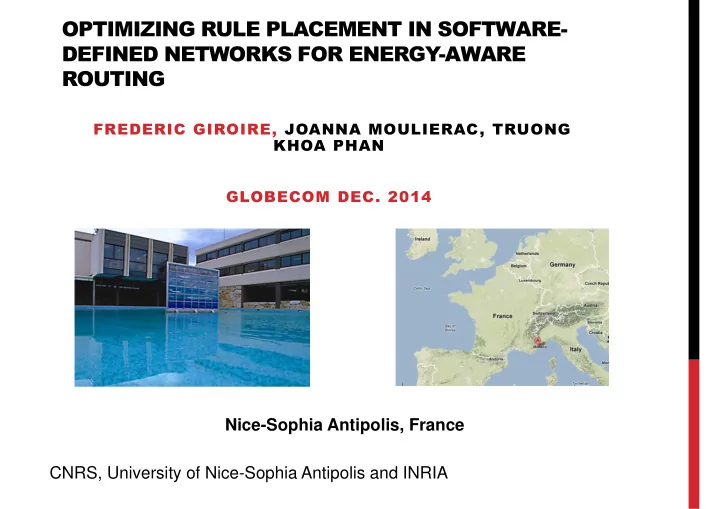

OPTIMIZING RULE PLACEMENT IN SOFTWARE- DEFINED NETWORKS FOR ENERGY-AWARE ROUTING FREDERIC GIROIRE, JOANNA MOULIERAC, TRUONG KHOA PHAN GLOBECOM DEC. 2014 Nice-Sophia Antipolis, France CNRS, University of Nice-Sophia Antipolis and INRIA
ENERGY CONSUMPTION OF TELECOM • Energy consumption and CO2 produced by ICT ~ 2% - 10% of the total world consumptions and man-made emissions by 2020. • The challenge of the European Commission: a 20% improvement in the EU’s energy efficiency by 2020. • Telecom infrastructure and devices account for 25% of the ICT’s energy consumption by 2020.
ENERGY AWARE ROUTING Measurements on energy consumption on routers [Chabarek et al. Infocom08] show: Small influence of traffic load [CSBE08]. To save energy: switch-off interfaces, chassis.
ENERGY AWARE ROUTING Routing solution minimizing the number of active links [CSBE08]. A link is turned off means two interfaces of routers are turned off. Energy-aware routing - turn off 10 links ~ 55% of energy saving Shortest path routing – turn off 8 links ~ 44% of energy saving
ENERGY , ROUTING AND SDN Software Defined Network: potential to bring into practice energy aware solutions. Traditional network: Routers and switches are “closed systems” → difficult to deploy new network protocols.
ENERGY , ROUTING AND SDN Software Defined Network: potential to bring into practice energy aware solutions. Centralized controller with computational capacity -> can dynamically adapt to traffic load.
ENERGY , ROUTING AND SDN Challenge : OpenFlow Switch can hold a limited number of rules.
ENERGY , ROUTING AND SDN Challenge : OpenFlow Switch can hold a limited number of rules. Routing tables:
OUR CONTRIBUTIONS Limited rule space important to put Energy Aware Routing (EAR) into practice. However, no work in literature addressing this problem for EAR. Our contributions: • Exact formulation and heuristic algorithm in case of routing tables with default rule. • Using real-life traffic traces, we quantify energy saving achieved by our approaches.
EXACT SOLUTION We succeeded in modeling the problem using linear programming. Goal: minimizing the number of active links while respecting capacity and rule space constraints Defaut port of router u � v : k uv = 1
HEURISTIC ALGORITHM H = subset of all network links While (Step 1 finishes with H) do: • Step 1: find feasible routing for all the demands with which respects the capacity and rule space constraints: • Free to assign rules for flows until routing table is full. • Then shrink the routing table using default rule. • Step 2: remove the less loaded link from H.
RESULTS Scenarios: Applied the Linear Program and the Heuristic Algorithms on the telecom network topologies and traffic matrices of the library SNDLib.
RESULTS An example: Telecom Austria (65 routers, 106 links)
RESULTS Unlimited rule space : infinite number of rules Standard rule space : 750 rules (TCAM memory) Minimum rule space : 695 (no solution with fewer)
CONCLUSIONS AND FUTURE WORK One step towards putting energy-efficiency into reality using SDN: • Solved issues in energy-aware traffic engineering about routing and software-defined networks. Future directions: • Considering side effects e.g. QoS when deploying EAR with SDN. • Minimizing rule space in SDN network using wild cards. • Study in data center networks.
CONCLUSIONS AND FUTURE WORK One step towards putting energy-efficiency into reality using SDN: • Solved issues in energy-aware traffic engineering about routing and software-defined networks. Future directions: • Considering side effects e.g. QoS when deploying EAR with SDN. • Minimizing rule space in SDN network using wild cards. • Study in data center networks. Thank you ! Questions ?
Recommend
More recommend